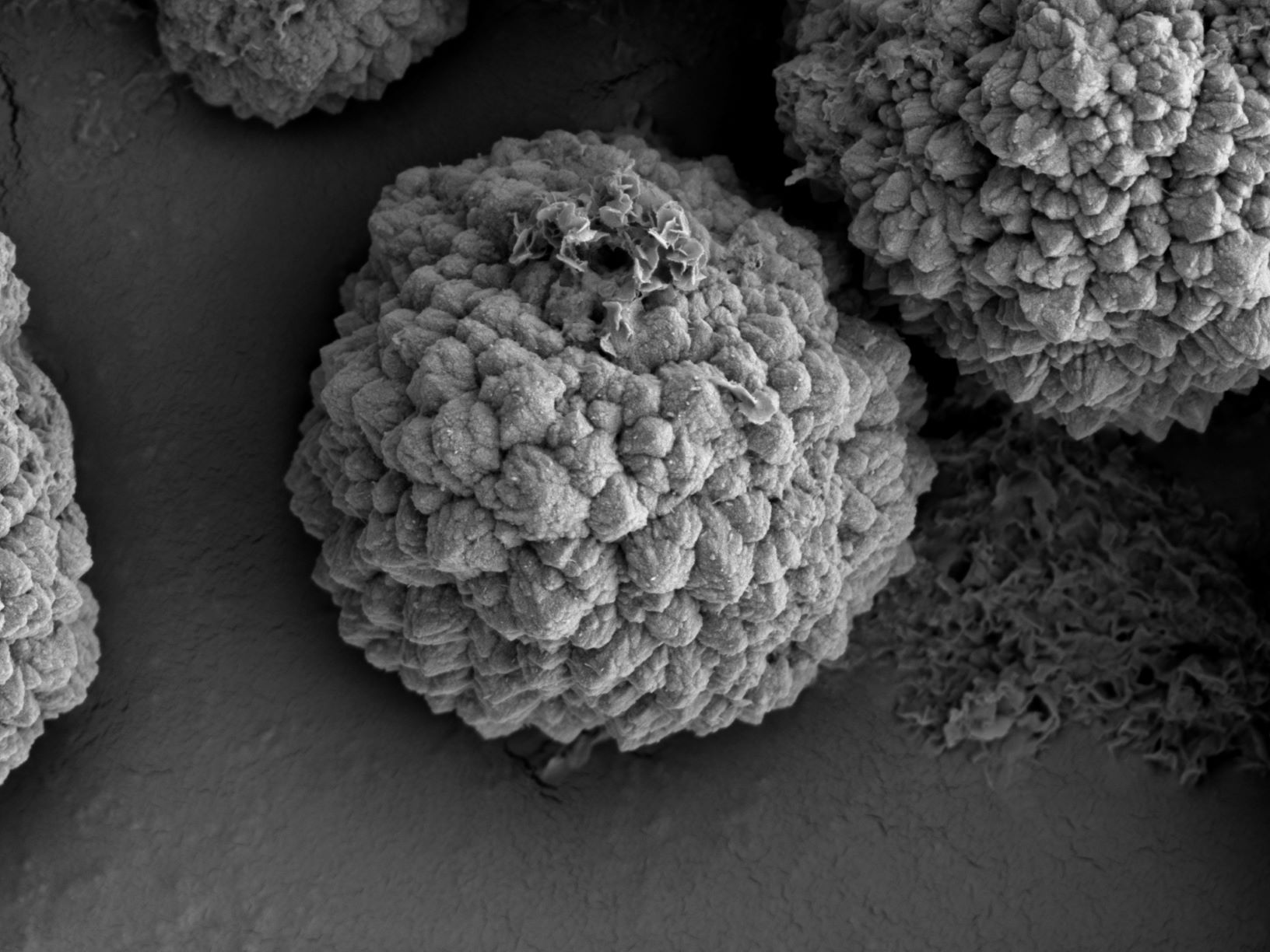Press Releases Archive
15.05.2024
Iron-sulfur minerals bear witness to earliest life on earth
Spherical pyrite from black smokers puts Tübingen and Göttingen researchers on the trail of the first microbes that lived billions of years ago
A team of researchers at the Universities of Tübingen and Göttingen has found that certain minerals with characteristic shapes could indicate the activity of bacteria in hydrothermal vents – or black smokers – in the deep ocean several billion years ago. This represents a major step in our understanding of the origin of life. The study, led by Eric Runge and Professor Jan-Peter Duda (now both at the University of Göttingen) and Professor Andreas Kappler and Dr. Muammar Mansor, geomicrobiologists at the University of Tübingen, has been published in the latest edition of Communications Earth & Environment.
The geological record shows that hot springs have existed on our planet for at least 3.77 billion years. Researchers consider that, due to their extremely dynamic physical and chemical conditions, hot spring systems may have given rise to organic substances and to the first life on Earth. Similar systems are thought to exist on other planets in our solar system, suggesting life could exist there too.
Tracing the evolutionary path
"In order to understand how life originated, we are following the evolution of microorganisms back billions of years. To do this, we are looking for traces of life, which we call biosignatures, in the oldest rocks on earth," explains Eric Runge, who conducted research at the University of Tübingen in a DFG-funded Emmy Noether working group led by Jan-Peter Duda before both scientists moved to the University of Göttingen. Runge says it is not always clear whether minerals in rocks are formed by the action of living organisms such as microorganisms or solely by chemical and physical processes. "We are honing our search for biosignatures, gaining a better understanding of how biologically formed minerals change over long geological periods," he says.
One particularly promising biosignature is the iron-sulfur mineral pyrite – “fool's gold” – which is abundant in hydrothermal vents on the ocean floor. Pyrite can either be formed directly or secondarily from the mineral magnetite when it reacts with sulfur-rich fluids found with it. Crucially, it occurs in various forms. "In our analyses, pyrite in its characteristic spherical form proved to be particularly interesting, with a structure similar to that of a raspberry," reports Andreas Kappler. "It only formed in this shape when the starting material – magnetite – was formed by iron-reducing bacteria."
Recreated in an experiment
In the absence of air, certain bacteria can grow and generate energy by transferring the electrons from their food, not to oxygen – as humans and other animals do – but to oxidized iron. This is reduced and magnetite can be formed; a process that is widespread in today's hydrothermal vents on the ocean floor. In the experiment, the research team has now simulated how magnetite reacts chemically with the sulfur-rich fluids produced there. To do this, they took both non-biologically formed magnetite and magnetite formed biologically in bacterial cultures, and exposed them separately to the conditions that prevail in the extreme habitats of today's magnetite-forming bacteria around black smokers.
"We observed that both the non-biological and biological magnetite were largely dissolved within hours. However, our investigations using a scanning electron microscope, which were carried out at the Tübingen Structural Microscopy Core Facility (TSM), showed that the crystal forms of the transformation products differed significantly after a few weeks," Runge reports. "While pyrite crystals – branched and shaped like fir trees – formed in the experiments with non-biological magnetite, the pyrite in the experiments with biological magnetite was more spherical." Such spherical pyrites can serve as fossil evidence for early bacterial life, Kappler says, "especially in the oldest rocks formed by hot springs on our planet."
"However, research into biosignatures is not relevant solely for deciphering the history of life on Earth," says Jan-Peter Duda. "Hot springs, similar to those on the ocean floor, could occur for example on Saturn's moon Enceladus. If there is life there, it is most likely to be microorganisms. Studies like ours provide the basis for recognizing the traces of such organisms."
Hydrothermal vents on the ocean floor, known as black smokers, emit volcanically heated fluids rich in dissolved metals and sulfur. These environments are oases of microbial activity on the ocean floor.
In the field studies on black smokers, robots are used to depths as great as 3000 meters; they are equipped with extensive sensor technology and can take samples of the fluids and rocks.
Publication:
Eric Runge, Muammar Mansor, Tsz Ho Chiu, Jeremiah Shuster, Stefan Fischer, Andreas Kappler & Jan-Peter Duda: Hydrothermal sulfidation of biogenic magnetite produces framboid-like pyrite. Communications Earth & Environment, https://doi.org/10.1038/s43247-024-01400-z
Contact:
Professor Dr. Andreas Kappler
University of Tübingen
Center for Applied Geoscience – Geomicrobiology
Phone +49 7071 29-74992
andreas.kapplerspam prevention@uni-tuebingen.de
Professor Dr. Jan-Peter Duda
Göttingen University
Geoscience Center – Geobiology
Phone +49 551 39 27922
jan-peter.dudaspam prevention@uni-goettingen.de
Eric Runge
Göttingen University
Geoscience Center – Geobiology
eric.runge1spam prevention@uni-goettingen.de
Contact for press:
Eberhard Karls Universität Tübingen
Public Relations Department
Oliver Häußler
Temporary Director
Janna Eberhardt
Research Reporter
Telefon +49 7071 29-77853
Fax +49 7071 29-5566
janna.eberhardtspam prevention@uni-tuebingen.de
All press releases by the University of Tübingen

